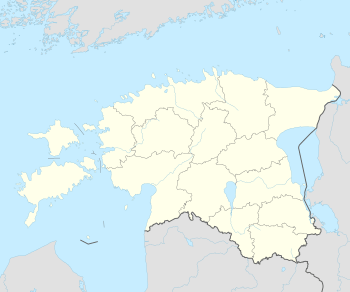Muuga, Lääne-Viru County
| Muuga | |
|---|---|
| Village | |
|
Muuga manor | |
 Muuga Location in Estonia | |
| Coordinates: 59°06′37″N 26°38′02″E / 59.11028°N 26.63389°ECoordinates: 59°06′37″N 26°38′02″E / 59.11028°N 26.63389°E | |
| Country |
|
| County | Lääne-Viru County |
| Parish | Laekvere Parish |
| Time zone | EET (UTC+2) |
| • Summer (DST) | EEST (UTC+3) |
Muuga is a village in Laekvere Parish, Lääne-Viru County, in northeastern Estonia.
Muuga manor

Muuga manor (German: Münkenhof) traces its history back to the 16th century, when it belonged to the Bridgettine convent in Pirita. During the course of history, it has subsequently belonged to various aristocratic families.[1]
In 1860, Muuga became the property of Carl Timoleon von Neff, a Baltic German painter who was the illegitimate son of a French governess. von Neff constructed the current neo-Renaissance building, intended not only as a home but also as a place to accommodate and display von Neff's large collection of art, which included both his own work and copies of old masters (now part of the Art Museum of Estonia). In many ways, Muuga under von Neff resembled a museum more than a home, and reflected von Neff's carefully orchestrated image.[2]
von Neff designed the building himself, with the aid of St. Petersburg architect Ludwig Bohnstedt, as well as, reputedly, Otto Pius Hippius, Alexander Brullov and David Grimm, all active in St. Petersburg. A concern was how to fit an enormous white marble staircase, a gift from the emperor Alexander II, into the building. The building received a sumptuous interior: terrazzo floors, marble and glazed fireplaces, painted walls and lunettes. Some of the walls were painted by his son, Heinrich.[3]
At the same time, the manor was complemented with a romantic park with ponds and annexes, including a belfry in the form of a neo-Gothic tower.[3]
The interiors were renovated 1987-1994.[3]
Estonian writer Eduard Vilde grew up in the manor.[3]
Gallery
 Main building from rear
Main building from rear Sculpture "Lying Lion" in the manor from the 19th century.
Sculpture "Lying Lion" in the manor from the 19th century. Monument of writer Eduard Vilde
Monument of writer Eduard Vilde Bell tower
Bell tower Manor's windmill
Manor's windmill Gate
Gate Muuga manor miller's house
Muuga manor miller's house
References
- ↑ Hein, Ants (2009). Eesti Mõisad - Herrenhäuser in Estland - Estonian Manor Houses. Tallinn: Tänapäev. p. 132. ISBN 978-9985-62-765-5.
- ↑ Abel, Tiina. Estonian Art 1' 2004 "Art Collection as a Manifesto" Check
|url=value (help). Estonian Institute. Retrieved 25 December 2012. - 1 2 3 4 Sakk, Ivar (2004). Estonian Manors - A Travelogue. Tallinn: Sakk & Sakk OÜ. p. 170. ISBN 9949-10-117-4.
External links
- Muuga manor at Estonian Manors Portal

